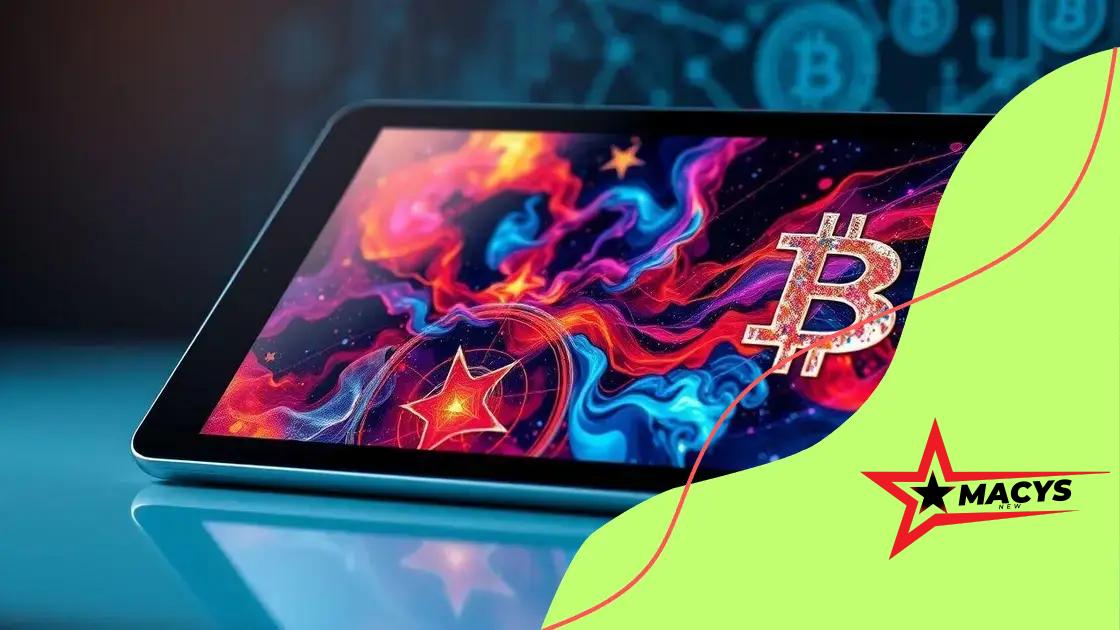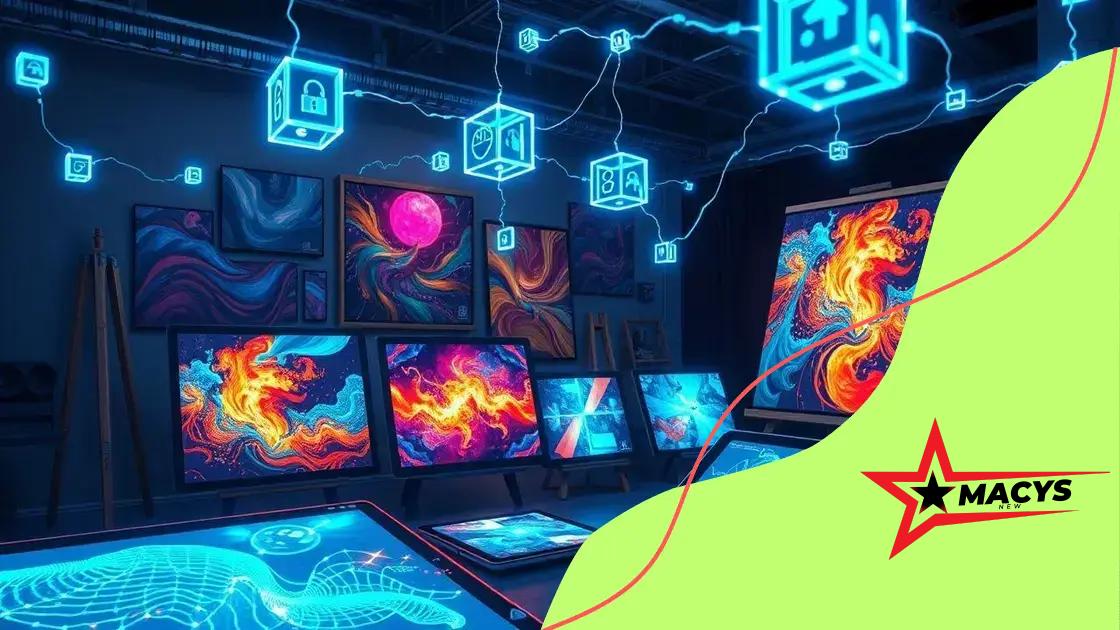Blockchain for digital art provenance: securing authenticity

This future of blockchain for digital art provenance ensures secure ownership and authenticity, allowing artists to protect their work, earn through NFTs, and engage directly with collectors while overcoming challenges like technical barriers and market volatility.
Blockchain for digital art provenance is changing the way we view ownership and authenticity in the art world. Imagine being able to trace the history of a piece of art with a few clicks. Curious about how this technology impacts artists and collectors alike? Let’s dive in!
Understanding blockchain technology
Understanding blockchain technology is essential to grasp how it impacts various industries, especially in the realm of digital art. This technology serves as a decentralized ledger, ensuring transparency and security in transactions. By using a network of computers, or nodes, it allows for data to be stored across multiple locations, making it very difficult to alter any recorded information.
Key Features of Blockchain
The core features of blockchain contribute to its reliability and trustworthiness. These include:
- Decentralization: Reduces the risk of a single point of failure.
- Immutability: Once recorded, the data cannot be changed without consensus.
- Transparency: All transactions are visible to participants, increasing trust.
- Security: Cryptographic techniques protect data against fraud.
These characteristics reinforce the notion that blockchain can drastically change the landscape of digital art. With traditional art forms, ownership can be easily disputed, and provenance can be hard to verify. However, using blockchain, artists can establish a clear, verifiable history of their work.
How Blockchain Works
Blockchain operates on a system of blocks and chains. Each block contains a list of transactions, and once it is filled, it is added to the chain in a linear, chronological order. This creates a permanent record, which is accessible to anyone on the network. Because each block is linked to the previous one, it’s incredibly difficult to modify the data without altering all subsequent blocks, essentially requiring the consensus of the majority of nodes. This process ensures that every transaction is validated and secure, solidifying trust among users.
Overall, understanding how blockchain technology functions lays the groundwork for appreciating its power in enhancing digital art’s authenticity. As more artists and collectors recognize these advantages, the acceptance and integration of this technology will continue to grow.
How blockchain ensures digital art authenticity
How blockchain ensures the authenticity of digital art is a key question for artists and collectors alike. In a world where digital copies can be easily made, it is crucial to have a method that verifies ownership and originality. This is where blockchain technology shines.
Verification of Ownership
Every piece of digital art can have its origins traced through a unique identifier stored on the blockchain. When an artist creates a new digital piece, they can register it on the blockchain, creating a permanent record. This record not only states who the creator is but also serves as proof of ownership.
- Registering works: Artists add their artworks to the blockchain upon creation.
- Digital certificates: Each artwork receives a digital certificate that verifies its originality.
- Historical records: The blockchain records all transactions and transfers of ownership.
This process offers several advantages. Firstly, it protects artists from theft and fraud. If someone tries to claim ownership of a piece they did not create, the public ledger will show the real owner. Second, collectors can confidently purchase works, knowing their value is backed by blockchain technology.
The Role of Smart Contracts
Another fascinating aspect is the use of smart contracts in the process. Smart contracts are self-executing contracts with the terms of the agreement written into code. When a digital art piece is sold, these contracts can automate the transaction, ensuring both parties uphold their end of the deal. For example, an artist can set a royalty percentage that will automatically return to them with every resale of their artwork.
This means that not only does blockchain make the initial sale secure, but it also preserves the artist’s rights long after the original transaction. This control over future sales is revolutionary for artists working in the digital space.
In essence, blockchain technology fosters an ecosystem where digital art is not just an image but a securely verifiable asset. This authenticity not only supports the value of individual pieces but also encourages a healthier relationship between creators and collectors.
Benefits of blockchain for artists

The benefits of blockchain for artists are numerous and significant. This innovative technology not only helps artists secure their works but also opens up new avenues for income and engagement. Artists can leverage blockchain technology to establish credibility and trust with collectors.
Enhanced Control Over Creations
With blockchain, artists have greater control over how their work is used and shared. By registering their art on the blockchain, they can prevent unauthorized copies and maintain ownership rights. This shifts the power back to the creators and protects their intellectual property.
- Ownership: Artists can prove original ownership effectively.
- Protection: It reduces the risk of art theft and plagiarism.
- Transparent sales: All transactions are recorded and visible to all parties involved.
This level of protection encourages more artists to share their work confidently. As a result, they can create without fear of losing their rights or being exploited.
New Revenue Streams
Another major advantage is the potential for new revenue streams. While traditional art sales often involve galleries taking substantial commissions, blockchain can change this model. By using platforms that operate on blockchain technology, artists can sell directly to buyers without intermediaries.
This direct-to-collector model allows artists to receive a larger share of the profits. Artists can also program smart contracts that allow them to earn royalties from secondary sales. This means that each time their art is resold, they receive a percentage of the sale price, ensuring ongoing revenue.
Furthermore, artists can experiment with new formats, like digital art and NFTs (non-fungible tokens), which can attract a broader audience. The expanding marketplace allows artists to showcase their diversity and creativity while earning fair compensation.
In conclusion, the advantages that blockchain technology offers to artists go beyond protecting their work. It empowers them to take control of their art, expand their income opportunities, and engage with their audience in unique ways.
Challenges in implementing blockchain for art
While blockchain technology offers exciting opportunities for the art world, it also presents certain challenges that need to be addressed. Understanding these hurdles is key for artists and collectors interested in leveraging this technology.
Technical Barriers
One major challenge is the technical complexity of blockchain systems. Understanding how to use these platforms can be overwhelming for those who are not tech-savvy. Many artists may find it difficult to navigate the blockchain landscape, which includes various platforms and protocols. This complexity can deter some from adopting the technology.
- Learning curve: Artists may need training to fully utilize the blockchain.
- Platform variety: Different blockchains can have unique features and requirements.
- Integration issues: Seamless integration with existing systems can be challenging.
These technical barriers can slow down the adoption of blockchain technology in the art world, limiting its potential benefits. If artists cannot easily access and use these technologies, they may miss out on new opportunities.
Market Volatility
Another challenge stems from the volatility of the crypto market. Prices for cryptocurrencies can fluctuate widely, impacting the stability of transactions. Artists may find it difficult to price their works when the underlying currency can change dramatically in value. This unpredictability can lead to hesitation in adopting blockchain solutions for art sales.
Moreover, if an artist chooses to sell their work as an NFT (non-fungible token), they must contend with the changing values of not only their artwork but also the digital currencies used to trade These tokens.
This market volatility can lead to uncertainty and risk, making some artists reluctant to embrace the change that blockchain technology represents. As the market stabilizes, however, confidence in these new methods may grow.
In summary, while the potential of blockchain technology for artists is immense, these challenges must be addressed. Tackling the technical barriers and market volatility will be crucial for broader adoption and success in the art world.
Future trends in digital art and blockchain
The future trends in digital art and blockchain technology are exciting and full of potential. As these two fields continue to evolve, they promise to reshape how art is created, sold, and experienced. Artists and collectors alike are beginning to explore innovative ways to combine creativity with technology.
Integration of Augmented Reality
One emerging trend is the integration of augmented reality (AR) with blockchain. AR can enhance digital art, allowing viewers to experience pieces in interactive ways. Imagine walking through a gallery where you can see artworks come to life through your smartphone or AR glasses. This integration can create a more engaging experience and attract a wider audience.
- Interactive Art: Artists can add layers of interaction, allowing users to engage with art.
- Enhanced Storytelling: Blockchain can be used to unlock additional content related to the artwork.
- Broader Appeal: Attracting a younger audience familiar with AR technology.
This merging of AR and blockchain demonstrates how technology can enrich the art experience and create new opportunities for artists.
Growth of NFTs
Another significant trend is the growth of non-fungible tokens (NFTs). NFTs have revolutionized how artists sell and showcase their work. As more artists and collectors understand the value of NFTs, we will likely see an expansion in the variety of digital art available. Artists will be able to create limited editions of their work and maintain more control over their sales.
NFTs also allow for innovative features, such as including royalties in sales for future transactions. This means that every time an artwork is resold, the original creator can earn a percentage. This creates exciting ongoing revenue opportunities for artists.
Decentralized Marketplaces
Decentralized marketplaces are another trend gaining traction. These platforms operate without a central authority and allow artists to connect directly with buyers. This shift can reduce fees associated with traditional art sales and give artists more control over their pricing.
As the art world embraces blockchain technology, more decentralized platforms will emerge, facilitating direct transactions and fostering community engagement among artists and collectors. This promotes a fairer ecosystem where creators are compensated more equitably for their work.
The fusion of digital art and blockchain technology will continue to develop. As these trends unfold, they promise to create a more inclusive and vibrant art market that empowers artists and gives collectors unique ways to experience and invest in art.
FAQ – Frequently Asked Questions about Blockchain and Digital Art
What is blockchain technology and how does it relate to art?
Blockchain technology is a decentralized digital ledger that securely records transactions, making it possible to verify ownership and authenticity of digital art.
How can artists benefit from using NFTs?
NFTs provide artists with a way to sell digital art as unique assets, allowing for royalties on resales and better control over their work.
What are some challenges in implementing blockchain for art?
Challenges include technical barriers that may overwhelm artists and market volatility that can affect pricing and stability.
What future trends can we expect in blockchain and digital art?
Expect integration of augmented reality, growth in NFTs, and the rise of decentralized marketplaces, creating more opportunities for artists and collectors.





